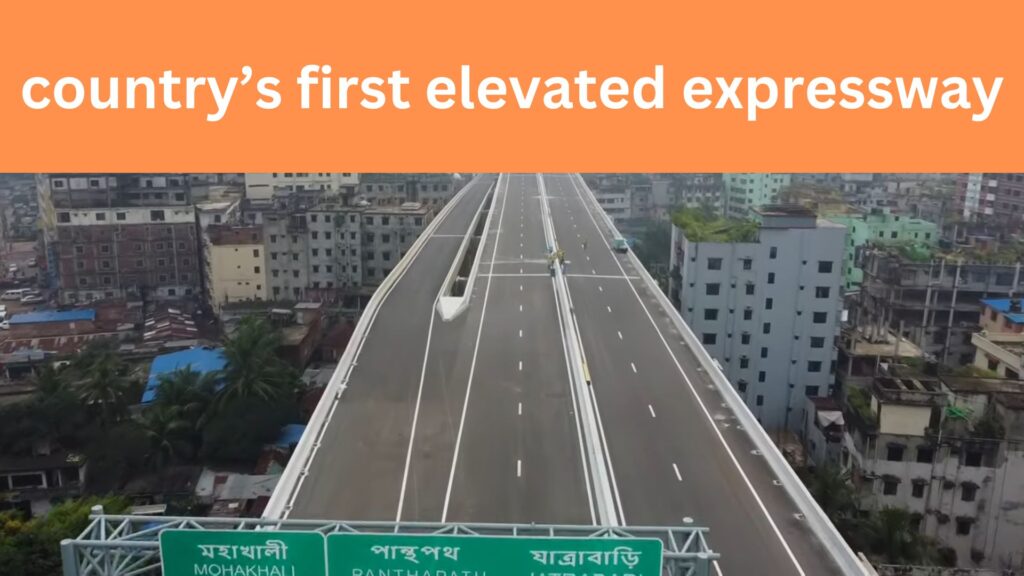Dhaka, the capital and largest city of Bangladesh, is home to more than 21 million people and one of the most densely populated cities in the world. The city is also notorious for its traffic congestion, which costs the economy an estimated $3.8 billion per year. However, a new project aims to change that: the Dhaka Elevated Expressway.
The Dhaka Elevated Expressway is a 46.73 km long elevated road that will connect Hazrat Shahjalal International Airport to Kutubkhali on the Dhaka-Chittagong Highway. The project, which was initiated in 2009, is expected to cost $1.84 billion and be completed by 2024. The main purpose of the expressway is to ease the traffic flow and improve the connectivity in the city.
The expressway will have several features that will make it a modern and efficient infrastructure for Dhaka. The expressway will be 20.5 meters wide, with four lanes in each direction, and have 24 ramps for entry and exit. The expressway will also have 10 toll plazas, equipped with electronic toll collection systems, and a central control centre for monitoring and managing the traffic. The expressway will allow only light vehicles, such as cars, buses, and trucks, and have a maximum speed limit of 80 km/h.
The expressway will cover a strategic route that will link different parts of the city and beyond. The expressway will start from the airport and pass through Banani, Mohakhali, Tejgaon, Moghbazar, Kamalapur, Jatrabari, and Kutubkhali. The expressway will also connect with other major roads, such as the Dhaka-Mawa Highway, the Dhaka-Tangail Highway, and the Dhaka-Sylhet Highway. The expressway will provide a faster and smoother access to the airport, the city centre, the industrial zones, and the port city of Chittagong.
The construction of the expressway is progressing at a steady pace, despite some challenges and delays. The construction is divided into three phases: Phase 1 from airport to Banani (8.91 km), Phase 2 from Banani to Moghbazar (9.86 km), and Phase 3 from Moghbazar to Kutubkhali (27.96 km). The construction of Phase 1 started in 2011 and was completed in 2019. The construction of Phase 2 started in 2016 and is expected to be completed by 2021. The construction of Phase 3 started in 2018 and is expected to be completed by 2024. Some of the challenges faced by the authorities and contractors include land acquisition, utility relocation, environmental clearance, design modification, and COVID-19 pandemic.
The expressway has achieved some remarkable milestones and achievements in its journey so far. One of them is the inauguration of the airport-Farmgate section (11.6 km) by Prime Minister Sheikh Hasina on March 18, 2021. This section is the first part of the expressway to be opened to traffic, and it has reduced the travel time from airport to Farmgate from more than an hour to less than 15 minutes. Another milestone is the completion of the Banani rail overpass (1.2 km), which is the longest rail overpass in Bangladesh and one of the longest in Asia. This overpass crosses over four railway tracks and two roads without any pillar or support.
The expressway will have a significant impact on the traffic situation and economic development of Dhaka. The expressway will reduce traffic congestion and shorten commuting times in the city, especially for airport-bound travelers. According to a study by Bangladesh University of Engineering and Technology (BUET), the expressway will save about 25 million hours of travel time per year for Dhaka residents. The expressway will also boost business and economic activities in the city, by facilitating trade, tourism, and investment. According to another study by BUET, the expressway will generate about $12 billion of economic benefits over its lifetime. The expressway will also improve the quality of life and environment in the city, by reducing noise, air pollution, and accidents. According to a report by Japan International Cooperation Agency (JICA), which is one of the partners of the project, the expressway will reduce carbon dioxide emissions by about 100,000 tons per year.
The Dhaka Elevated Expressway is a game-changer for Dhaka. It is a modern and efficient infrastructure that will ease the traffic flow and improve the connectivity in the city. It is also a catalyst for economic growth and social development in the city. The expressway is a testament to the vision and commitment of the government and the partners of the project, who have overcome various challenges and obstacles to make it a reality. The expressway is a pride and joy for Dhaka and Bangladesh.
However, the expressway is not a panacea for all the traffic woes of Dhaka. There are still some areas that need further improvement or expansion, such as the integration of public transport, the enforcement of traffic rules, and the maintenance of road safety. The expressway is also not a substitute for a holistic and sustainable urban planning, which should consider the needs and aspirations of all the stakeholders, including the residents, businesses, and visitors of Dhaka.
What do you think of the Dhaka Elevated Expressway? Do you think it will make a difference in your life? Share your thoughts and opinions with us in the comments section below.
Dhaka Elevated Expressway is now open to all
Prime Minister Sheikh Hasina inaugurated the Airport-Farmgate part of the Dhaka Elevated Expressway on 2 September
This section has 15 ramps for accessing and exiting the expressway. The authority also fixed the toll fee of the expressway.

Bangladesh’s first elevated Expressway will connect Dhaka Airport with Kutubkhali. It is one of the biggest infrastructure projects that will make Dhaka city connectivity easier.
In January 2011, the Bangladesh Bridge Authority (BBA) signed a deal with the Italian-Thai Development Public Company to build the expressway.
Dhaka Elevated Expressway will be 46.73 km long including the connecting roads and will cost around US$1.3 billion. It will connect Airport, Kuril, Banani, Mohakhali, Tejgaon, and Kamalapur to Dhaka Chittagong Highway.






